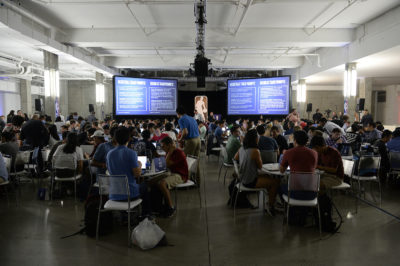
Sports can be a mix of athleticism, grit and flare on-screen, but the behind-the-scenes activities are what transform them into televised spectacles.
One of those activities includes data analytics, a field that permits only the brightest technology aficionados. As of recent, the NBA has sought to expand the impact of data analytics on professional basketball.
On Sept. 23 and 24, some of the most technologically savvy undergraduate and graduate students in the country were invited to the second annual NBA Hackathon at Skylight Modern in New York City. Over 900 students applied, but only 207 students, forming 60 teams, earned invitations to the exclusive event.
Among those selected was a team of four students from Boston University.
Team BU Ballers included sophomore Rudhra Raveendran, sophomore Charles Ma, junior Ibrahim Shaikh and graduate student Kinan Dak Albab. While these students have competed in many hackathons, this one, from the application process to the event itself, was unique.
“We had to answer preliminary questions … They gave us statistics on the Golden State Warriors and on Kevin Durant … [and] we had to figure out the likelihood that the Warriors wouldn’t lose two-consecutive games in a full season if Kevin Durant joined their team,” Shaikh said.
As a somewhat unconventional method of learning and competing, student hackers pulled all-nighters and worked for 24 hours as they assembled either individual or team projects.
For a basketball enthusiast like Shaikh, the convergence of business intelligence with basketball at the NBA hackathon was perfect, he said.
“I really love basketball,” Shaikh said. “My friends told me that the NBA was hosting a hackathon. This was going to be my second hackathon … I knew that it [would last] anywhere from eight to 36 to 48 hours straight … [and we would have to] finish a project from inception.”
In NYC, the NBA hackathon competition was separated into two tracks, basketball and business.
Those competing on the basketball track tackled a slate of problems related to the game, particularly those of interest to coaches and managers.
Conversely, business track hackers solved issues relating to commercial value, things of great importance to those in back end operations.
“They gave us an absurd amount of data,” Shaikh said. “We were given exact locational coordinates of the players on the floor every like 40 milliseconds … it was insane.”
The BU Ballers competed on the basketball track, looking to solve several on-floor issues of the game.
After hours of going through piles of data covering the past four years, the Ballers found that the number of three-point field goals made failed to rise in proportion to the exponential increase in the number of those attempted.
“We had to find a trend in the last four years and predict where that trend would go in the next ten years,” Shaikh said. “We found that three-point shots are going through the roof, they’re skyrocketing … [but] players are shooting more threes and are making just as many in the past … nobody wants to see people throwing up shots and missing them.”
Their analysis found that the implementation of a 1-4 defense would drastically reduce the number of three-point attempts, and consequently, the skill and competitiveness of the game would be restored, further stoking fan interest and ultimately growing the bottom line.
“We took the data and ran a lot of simulations. With one man in the paint and four men guarding the perimeter, the 1-4 defense would reduce three point attempts … it would make the game more interesting … fans are going to be happier which leads to more money for the NBA,” Shaikh said.
The coach of the Ballers helped out with the data, providing advice that helped steer the team in the right direction, Shaikh said.
“Our coach told us to put ourselves in the shoes of the NBA,” Shaikh said. “It’s a business so you have to satisfy the customers first … you have to give a solution that the NBA could actually implement.”
The realm of data analytics is boundless for sports, he added.
More data that is available allows teams to better analyze different playing and coaching styles, which could ultimately improve the quality of the game.
“When you do analytics in sports it opens up a whole new dimension of the game,” Shaikh said. “The more data you have the more effective you’re going to be as a team and as a player … data is going to be a huge part in the NBA and in sports.”
However, the NBA Hackathon was not simply a competition. It was also an interactive event geared toward learning.
During the hackathon, some NBA players showed up. Brooklyn Nets forward Rondae Hollis-Jefferson and New York Knicks guard Tim Hardaway Jr. arrived to check out the hackathon. Sports analysts including FiveThirtyEight’s editor-in-chief Nate Silver, Brooklyn Nets head coach Kenny Atkinson and even NBA commissioner Adam Silver conducted and judged the event as well.
With such high-profile guests and a hacking opportunity, the BU Ballers said they’d be back.
“I definitely plan on applying to the NBA hackathon again next year,” Shaikh said.




















































































































